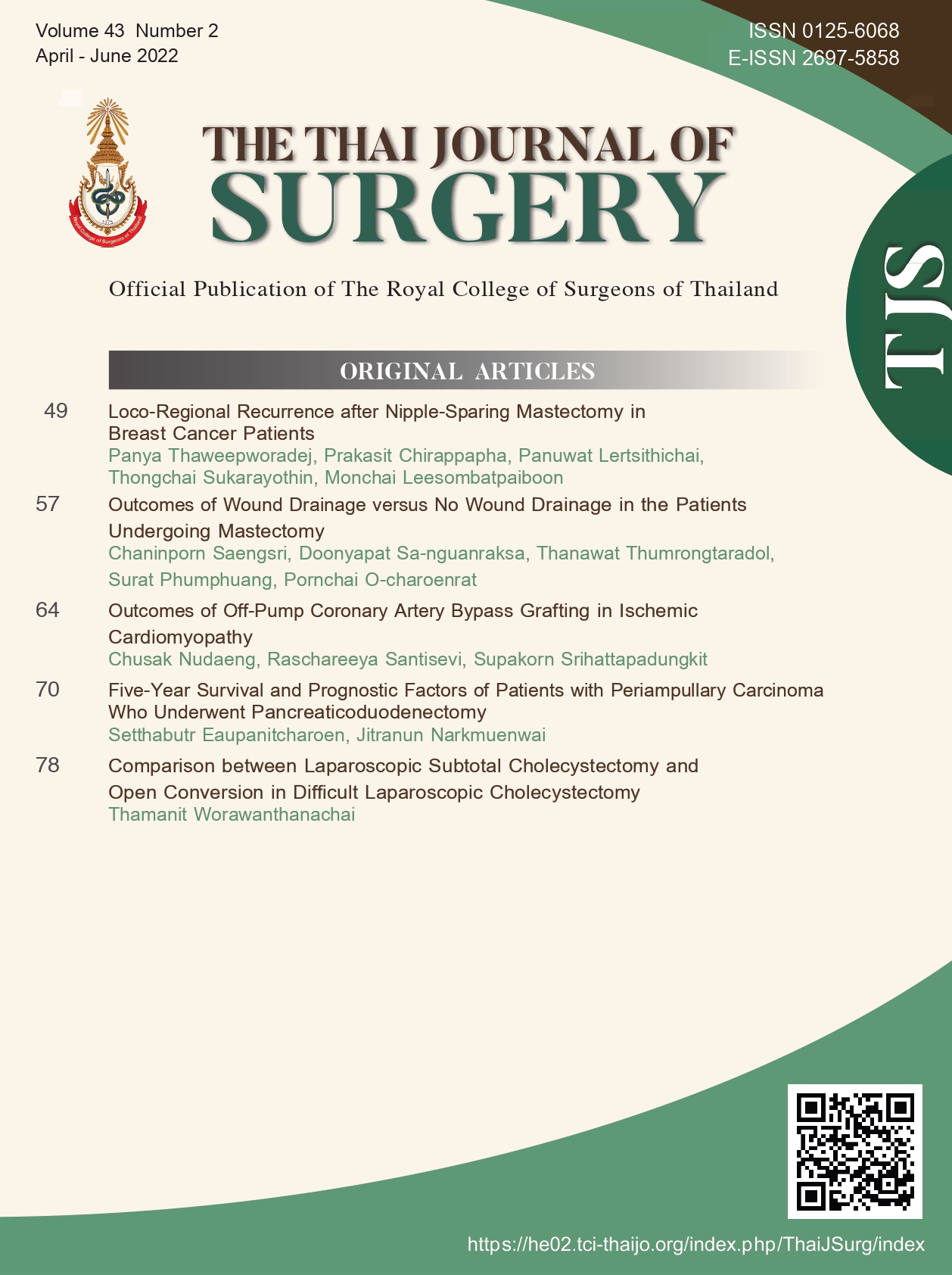Loco-Regional Recurrence after Nipple-Sparing Mastectomy in Breast Cancer Patients
Keywords:
Breast cancer, Locoregional recurrence, Nipple-areolar complex-sparing mastectomy, Nipple-sparing mastectom, Oncologic safetyAbstract
Objectives: There are relatively few studies of locoregional recurrence (LRR) after nipple-sparing mastectomy (NSM) for breast cancer. The aim of the present study was to determine the oncologic safety of nipple-areolar complex (NAC)-sparing mastectomy in breast cancer patients and to determine risk factors for LRR.
Materials and Methods: We analyzed 65 NSMs that were performed on 63 patients for both therapeutic and prophylactic indications between January 2007 and June 2017. Patient demographics, operative details, oncologic outcomes, and postoperative complications were recorded. Factors associated with LRR were also analyzed.
Results: The mean age of the patients was 43 years (range, 30 to 61 years). Fifty-eight NSMs (89%) were performed for cancer treatment. Skin necrosis was the most common complication (19%), but most cases were successfully managed conservatively. Fifty-one NSMs were included in the oncologic evaluation. Forty of 51patients (78%) underwent surgery for invasive breast cancer, and the rest had carcinoma in situ. After a mean follow-up period of 70 months (24 to 162 months), four patients (8%) developed LRR, with mostly in the regional lymph nodes. Only one patient developed Paget’s disease of the nipple after surgery and required NAC excision. Five-year disease-free survival was 87%. In a subgroup analysis, only tumor size and Ki-67 level showed an association with LRR, but only Ki-67 level was statistically significant (HR 1.07; 95% CI 1.00 to 1.15).
Conclusion: NSM is oncologically safe and is technically feasible in selected patients. A low rate of LRR was also observed. Only Ki-67 level showed an association with LRR. Long-term outcomes should be closely monitored.
References
Ferlay J, Soerjomataram I, Ervik M, et al. GLOBOCAN 2012 v1.0, Cancer Incidence and Mortality Worldwide: IARC Cancer Base No. 11. Lyon, France: International Agency for Research on Cancer; 2013. Available from: http://globocan.iarc.fr, accessed on 24 July 2018.
Wickerham DL, Costantino JP, Mamounas EP, et al. The landmark surgical trials of the National Surgical Adjuvant Breast and Bowel Project. World J Surg 2006;30:1138-46.
Toth BA, Lappert P. Modified skin incisions for mastectomy: the need for plastic surgical input in preoperative planning. Plast Reconstr Surg 1991;87:1048-53.
Didier F, Radice D, Gandini S, et al. Does nipple preservation in mastectomy improve satisfaction with cosmetic results, psychological adjustment, body image and sexuality? Breast Cancer Res Treat 2009;118:623-33.
Freeman BS. Subcutaneous mastectomy for benign breast lesions with immediate or delayed prosthetic replacement. Plast Reconstr Surg. 1980;65(3):371-2.
Freeman BS. Subcutaneous mastectomy for benign breast lesions with immediate or delayed prosthetic replacement. Plast Reconstr Surg Transplant Bull. 1962;30:676-82.
Murthy V, Chamberlain RS. Defining a place for nipple sparing mastectomy in modern breast care: an evidence-based review. Breast J 2013;19:571-81.
Wellings SR. A hypothesis of the origin of human breast cancer from the terminal ductal lobular unit. Pathol Res Pract 1980;166:515-35.
Wellings SR, Jensen HM. On the origin and progression of ductal carcinoma in the human breast. J Natl Cancer Inst 1973;50:1111-8.
Montagna W. Histology and cytochemistry of human skin. XXXV. The nipple and areola. Br J Dermatol 1970;83:Suppl:2-13.
Love SM, Barsky SH. Anatomy of the nipple and breast ducts revisited. Cancer 2004;101:1947-57.
Taneri F, Kurukahvecioglu O, Akyurek N, et al. Microanatomy of milk ducts in the nipple. Eur Surg Res 2006;38:545-9.
Rosen PP, Tench W. Lobules in the nipple. Frequency and significance for breast cancer treatment. Pathol Annu 1985;20 Pt 2:317-22.
Stolier AJ, Wang J. Terminal duct lobular units are scarce in the nipple: implications for prophylactic nipple-sparing mastectomy: terminal duct lobular units in the nipple. Ann Surg Oncol 2008;15:438-42.
Headon HL, Kasem A, Mokbel K. The oncological safety of nipple sparing mastectomy: a systematic review of the literature with a pooled analysis of 12,358 procedures. Arch Plast Surg 2016;43:328-38.
Chirappapha P, Srichan P, Lertsithichai P, et al. Nipple-Areola Complex Sensation after Nipple-sparing Mastectomy. Plast Reconstr Surg Glob Open 2018;6:e1716.doi: 10.1097/GOX.0000000000001716.
Chirappapha P, Petit JY, Rietjens M, et al. Nipple sparing mastectomy: does breast morphological factor related to necrotic complications? Plast Reconstr Surg Glob Open. 2014;2(1):e99.doi:10.1097/GOX.0000000000000038.
Petit JY, Veronesi U, Orecchia R, et al. Risk factors associated with recurrence after nipple-sparing mastectomy for invasive and intraepithelial neoplasia. Ann Oncol 2012;23:2053-8.
Downloads
Published
How to Cite
Issue
Section
License
Copyright (c) 2022 The Royal College of Surgeons of Thailand

This work is licensed under a Creative Commons Attribution-NonCommercial-NoDerivatives 4.0 International License.
Articles must be contributed solely to The Thai Journal of Surgery and when published become the property of the Royal College of Surgeons of Thailand. The Royal College of Surgeons of Thailand reserves copyright on all published materials and such materials may not be reproduced in any form without the written permission.



